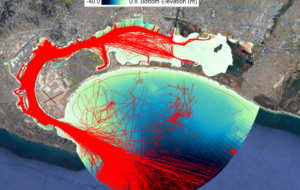The Importance of Propeller Wash Modeling
Many urban waterfronts are contaminated with metals, petroleum hydrocarbons, and other organic chemicals, often as deep as 20 feet within the sediment bed. Most sources of this type of contamination are historical, including dumping, spillage, and other point and non-point sources. DSI’s EFDC+ Explorer Modeling System (EEMS) has proven to be an effective tool in evaluating toxic sediment transport patterns as part of cleanup efforts; now DSI is taking its modeling software to the next level.
Cleanup of contaminated sediment sites may include dredging, capping, or in-situ treatment, or a combination of these three techniques. Long-term stability of sediments is key to the success of these remedial actions, which must withstand recontamination by sediments from other sites, as well as resuspension of bottom sediments, a significant source of recontamination (Michelson, 1998). Vessel traffic (propeller wash or “propwash”) correlates closely with increases in sediment resuspension. The contaminated sediment can also be further transported by currents induced by vessel traffic.
Over the years, multiple field studies have collected data related to sediment resuspension and vessel traffic (Hayes, 2010). One such study conducted in San Diego Bay showed that berthing/docking at only three naval piers resuspended a total of 26 tons per day of sediments into the water column (Wang et al., 2000).
Propwash has also been attributed to be the main cause of scour around quay structures; such scour may result in structural instability, or even failure (PIANC, 2015). A study of ferry vessel propwash effects on scour at the Kingston Ferry Terminal in Washington state (Kastner et al., 2019) found that vessel arrivals and departures are associated with 10 to 30 times higher water velocities and 10 to 100 times higher resulting shear stresses than ambient conditions.
Modeling water and sediment transport patterns due to propwash in near shore areas is critical to planning successful cleanup, preventing resuspension, and designing structures to avoid development of scour holes. Unfortunately, limited availability of field data, computing capabilities, and other resources have hampered efforts to model propwash-related sediment resuspension. The available propwash models are empirical models that only address velocity and shear at the sediment interface; these are decoupled from far field transport and ignore propeller velocities in the water column.
As an enhancement of its EEMS software, DSI is currently developing a fully integrated propwash module that will be able to predict sediment resuspension using ship information, position, and speed, dynamically combined with a three-dimensional model of the waterbody. Optionally, the propeller energy can be incorporated into the three-dimensional flow field behind the ships. The EEMS propwash module may be a game changer for contaminated sediment remediation teams in their efforts to properly consider the role of propwash in their evaluations and designs, and for port and harbor engineers evaluating foundation and bulkhead impacts due to propeller action.
Want to give EEMS a try with propwash? You can start by downloading EEMS and activating in the free demo mode and the running our demonstration model. To see these features in action, head over to our YouTube page. Also, learn more technical details of the implementation of this feature by reading our whitepaper on propwash.
Talk to the experts
References












